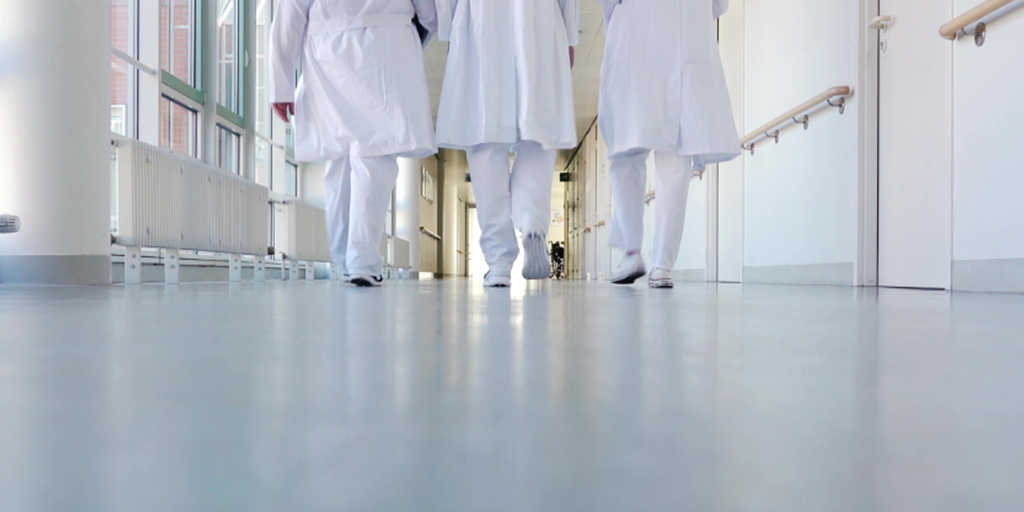In a hospital, it is not unusual for various fluids to be found spilled on the floor. These fluid wastes include contaminants like urine, blood, vomit, and stool. According to the National Safety Council, falls are one of the leading causes of accidental injuries in the U.S. These unintentional falls account for roughly 8.9 million visits to the emergency department each year. [1] In addition, falls are the second-leading cause of accidental death, resulting in more than 25,000 fatalities in 2009 alone. [2]
It may not seem obvious but keeping your floors clean and dry in these healthcare settings is critically important. The Centers for Disease Control and Prevention found that contaminants spilled on the floor are one of the leading causes of slip, trip, and fall (STF) accidents in healthcare facilities. [3] So many fluids are being moved or transferred in a healthcare setting; thus, slipping is a constant risk for many healthcare workers. For example, nurses change IVs, patient clothing, syringes, and incontinence devices such as catheters, which can all lead to a potential spillage of fluids.
Additionally, most healthcare facilities have tile or vinyl, which is slippery and increases the frequency of STFs. These slip-and-fall accidents often cause debilitating injuries that can affect healthcare workers’ ability to care for patients properly. [4] These incidents can also cause lost workday injuries in hospitals, leading to compensation claims and reduced productivity. Moreover, if a patient falls, this can potentially result in severe disabilities or even death. In 2007, the Bureau of Labor Statistics found that the rate of lost workday injuries from STFs in hospitals was 75% higher than the average for any other private industry. [5]
Consider the daily routine of a nurse in a critical care unit. Patients use external catheters in many settings due to mobility issues or other clinical needs. The existing external catheters need to be changed every few hours and fill up quickly with urine. Due to the design of these catheters, liquid waste and leakage become an issue. During removal, the urine tends to spill on the floor, the nurse’s shoes, the patient, the bedding, and the nurse’s scrubs. This is an issue that many nurses face daily. Unfortunately, nurses reported the highest number of hospital STF-related claims and injury events. [6] However, our revolutionary new product can eliminate this liquid waste problem and help prevent future STF-related accidents.
The CareDry® System is a revolutionary system in urine management made with medical-grade foam that protects against leaks in any position by contouring to the patient’s unique body shape. It is also 100% moisture-wicking with optimal pore size and a foam structure with 5x the surface area of leading competitors. The CareDry® System provides rapid dryness and comfort for patients while preventing leaks on the patient, their bedding, floor, or healthcare workers. In addition, the anti-microbial sponge actively inhibits harmful bacteria formation, allowing for extended patient use with a Q24 change interval. This will enable nurses to save time and worry less about changing external catheters on their rounds.
The CareDry® system can help decrease the potential for slip, trip, and fall incidents in hospitals across the country. Contact us today to learn more about our new external catheter and how it can rapidly change your hospital.
[1] (2014, August 22). Avoiding slip and fall accidents in healthcare facilities. Healthcare Facilities Today.
[2] (2020, March 25). CDC releases top 10 causes of injury in the US. https://www.mdlinx.com/article/cdc-releases-top-10-causes-of-injury-in-the-us/lfc-4148
[3] Department of Health and Human Services. “Slip, Trip, and Fall Prevention for Healthcare Workers.” 10 July 2020, www.cdc.gov/niosh/docs/2011-123/, 10.26616/NIOSHPUB2011123.
[4] Mullins, T. “Slips, Trips, and Falls: Protect Your Employees from Preventable Injuries.” OSHA: National Safety Compliance, 24 Mar. 2021.
[5] Jennifer L. Bell, James W. Collins, Laurie Wolf, Raoul Grönqvist, Sharon Chiou, Wen-Ruey Chang, Gary S. Sorock, Theodore K. Courtney, David A. Lombardi & Bradley Evanoff(2008) Evaluation of a comprehensive slip, trip and fall prevention programme for hospital employees, Ergonomics, 51:12, 1906-1925, DOI: 1080/00140130802248092
[6] Sharla Drebit, Salomeh Shajari, Hasanat Alamgir, Shicheng Yu & Dave Keen (2010) Occupational and environmental risk factors for falls among workers in the healthcare sector, Ergonomics, 53:4, 525-536, DOI: 10.1080/00140130903528178
Back to Blog


